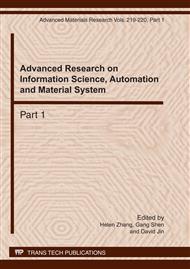p.49
p.53
p.57
p.61
p.66
p.71
p.76
p.80
p.84
Self-Embedding Watermark for Image Restoration Based on Repeat Correcting Code
Abstract:
A simple image restoration scheme based on watermark is proposed in this paper. In the watermark scheme, an image is divided into multi-blocks. Repeat correcting code is adopted to be a copy of the most significant bits (MSBs) which will be selected as watermark that embedded into the least significant bits (LSBs). There are two shares of MSBs and scattered in the LSBs within other blocks. In order to avoid tampering coincidence and to improve the ability of restoration, the distance among the original block and other two blocks that their shares belong to is optimized as long as possible. The experiments indicate that this scheme is simple and easy to implement and the smaller the tampered area, the more pixels in the tampered area can be recovered correctly.
Info:
Periodical:
Pages:
66-70
Citation:
Online since:
March 2011
Authors:
Keywords:
Price:
Сopyright:
© 2011 Trans Tech Publications Ltd. All Rights Reserved
Share:
Citation:


